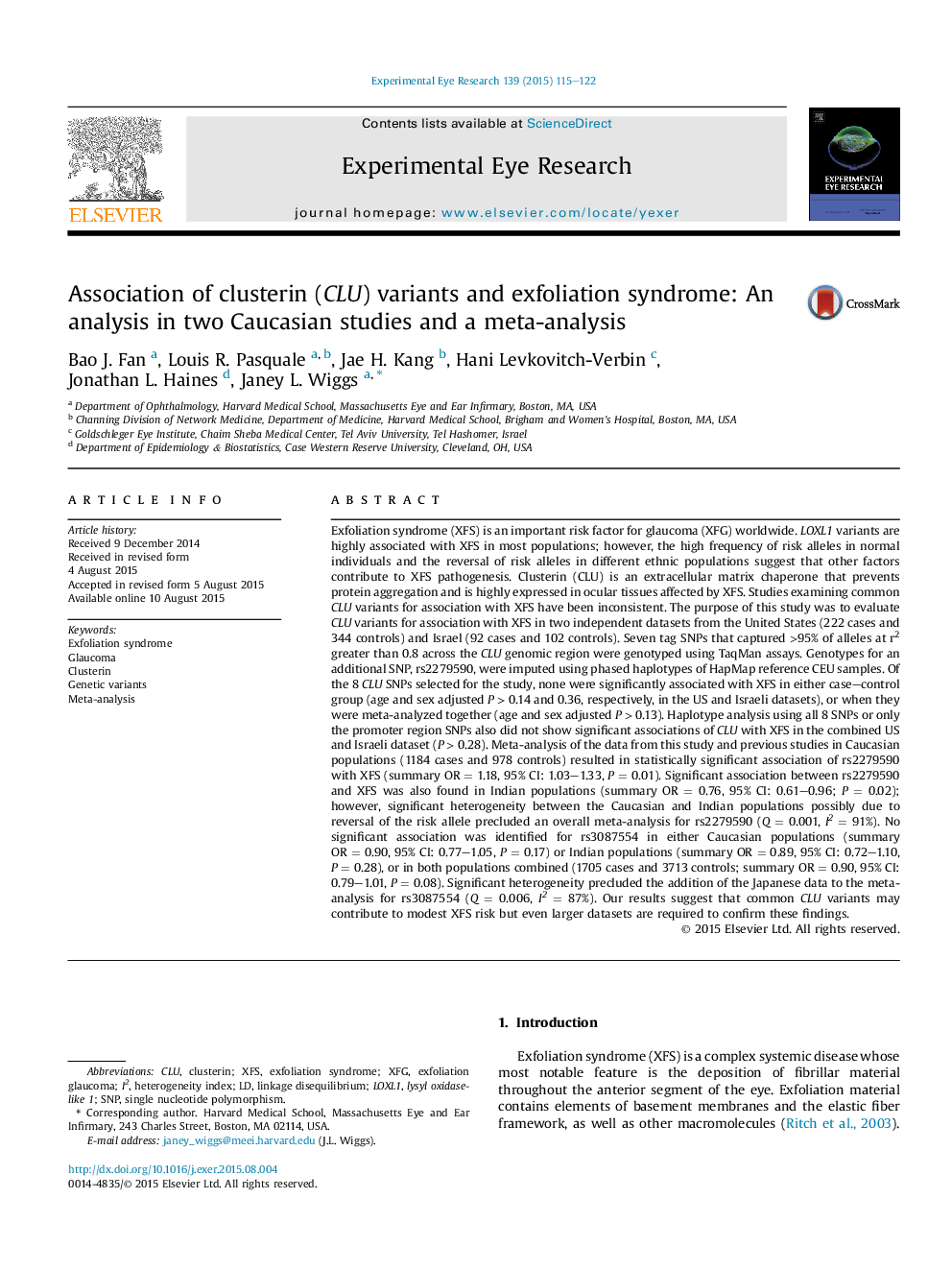| کد مقاله | کد نشریه | سال انتشار | مقاله انگلیسی | نسخه تمام متن |
|---|---|---|---|---|
| 4011134 | 1602583 | 2015 | 8 صفحه PDF | دانلود رایگان |

• We comprehensively evaluated CLU (clusterin) SNPs for association with exfoliation syndrome in two Caucasian case/control samples.
• We examined CLU haplotypes in both Caucasian case/control samples.
• We performed a meta-analysis for two CLU SNPs in our data as well as published data in European Caucasians, and case/control samples from India and Japan.
Exfoliation syndrome (XFS) is an important risk factor for glaucoma (XFG) worldwide. LOXL1 variants are highly associated with XFS in most populations; however, the high frequency of risk alleles in normal individuals and the reversal of risk alleles in different ethnic populations suggest that other factors contribute to XFS pathogenesis. Clusterin (CLU) is an extracellular matrix chaperone that prevents protein aggregation and is highly expressed in ocular tissues affected by XFS. Studies examining common CLU variants for association with XFS have been inconsistent. The purpose of this study was to evaluate CLU variants for association with XFS in two independent datasets from the United States (222 cases and 344 controls) and Israel (92 cases and 102 controls). Seven tag SNPs that captured >95% of alleles at r2 greater than 0.8 across the CLU genomic region were genotyped using TaqMan assays. Genotypes for an additional SNP, rs2279590, were imputed using phased haplotypes of HapMap reference CEU samples. Of the 8 CLU SNPs selected for the study, none were significantly associated with XFS in either case–control group (age and sex adjusted P > 0.14 and 0.36, respectively, in the US and Israeli datasets), or when they were meta-analyzed together (age and sex adjusted P > 0.13). Haplotype analysis using all 8 SNPs or only the promoter region SNPs also did not show significant associations of CLU with XFS in the combined US and Israeli dataset (P > 0.28). Meta-analysis of the data from this study and previous studies in Caucasian populations (1184 cases and 978 controls) resulted in statistically significant association of rs2279590 with XFS (summary OR = 1.18, 95% CI: 1.03–1.33, P = 0.01). Significant association between rs2279590 and XFS was also found in Indian populations (summary OR = 0.76, 95% CI: 0.61–0.96; P = 0.02); however, significant heterogeneity between the Caucasian and Indian populations possibly due to reversal of the risk allele precluded an overall meta-analysis for rs2279590 (Q = 0.001, I2 = 91%). No significant association was identified for rs3087554 in either Caucasian populations (summary OR = 0.90, 95% CI: 0.77–1.05, P = 0.17) or Indian populations (summary OR = 0.89, 95% CI: 0.72–1.10, P = 0.28), or in both populations combined (1705 cases and 3713 controls; summary OR = 0.90, 95% CI: 0.79–1.01, P = 0.08). Significant heterogeneity precluded the addition of the Japanese data to the meta-analysis for rs3087554 (Q = 0.006, I2 = 87%). Our results suggest that common CLU variants may contribute to modest XFS risk but even larger datasets are required to confirm these findings.
Journal: Experimental Eye Research - Volume 139, October 2015, Pages 115–122